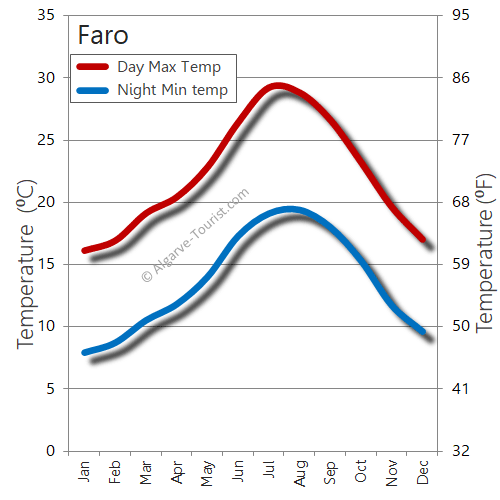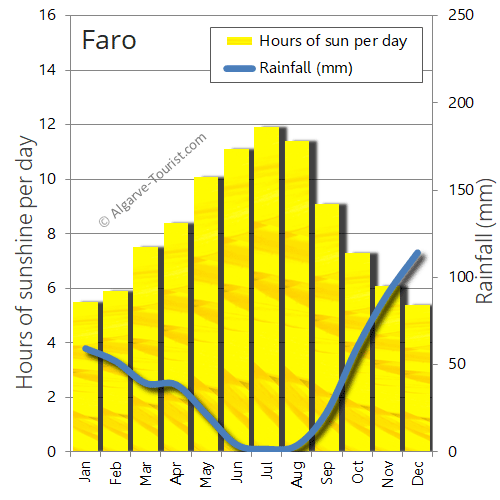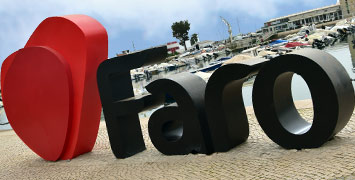Algarve-Tourist.com
The best independent guide to the Algarve
Algarve-Tourist.com
The best independent guide to the Algarve
Faro, Portugal: an independent tourism guide for 2025
Faro is the historic and authentic capital of the Algarve. While often overlooked by visitors rushing to the coast, the city richly rewards those who choose to linger. It offers a distinct Portuguese experience, blending a beautifully preserved old town with the magnificent natural landscapes of the Ria Formosa.
Enclosed by ancient Moorish walls, the Cidade Velha (Old Town) is the heart of the city. Here, a charming labyrinth of cobbled streets opens onto quiet squares, leading to the imposing Gothic Sé Cathedral and the elegant Bishop’s Palace. Beyond the monumental Arco da Vila gateway lies a lively modern city, with pedestrianised shopping streets, bustling cafés, and a marina that serves as the departure point for exploring the region’s greatest natural treasure.
To the south lies the Parque Natural da Ria Formosa, a stunning coastal lagoon of tidal marshes, saltwater channels and barrier islands. This vital ecosystem, a haven for migratory birds, is also home to the Algarve’s most pristine and secluded beaches, reachable only by ferry.
With its unique blend of cultural attractions and wonderful natural scenery, Faro provides a memorable Portuguese experience, perfect for a single day of exploration or as an excellent base for discovering the quieter eastern Algarve.
This guide explains why you should visit Faro and provides everything required to get the most from this fascinating city.
Highlights of Faro
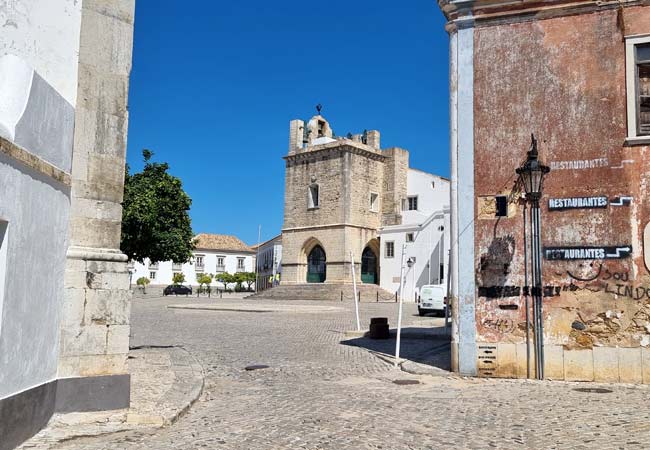
Largo da Sé: A charming cobbled plaza located in the centre of Faro’s historic district, home to several important landmarks, including the old cathedral, the Bishop’s Palace, and the city hall.
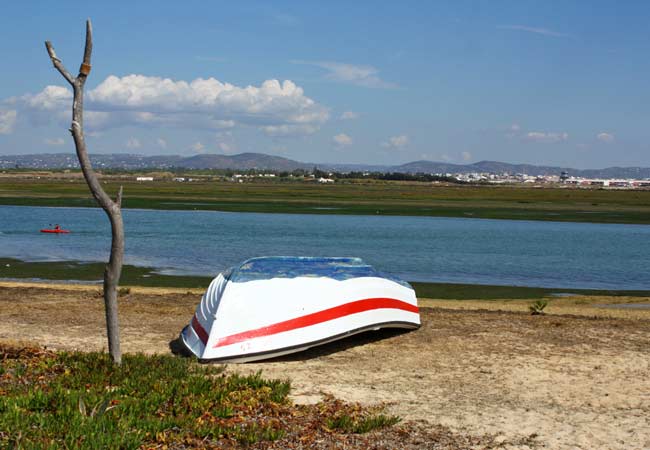
Parque Natural da Ria Formosa: A network of saltwater lagoons and sheltered waterways, rich with aquatic life and best explored by boat tour or kayak.
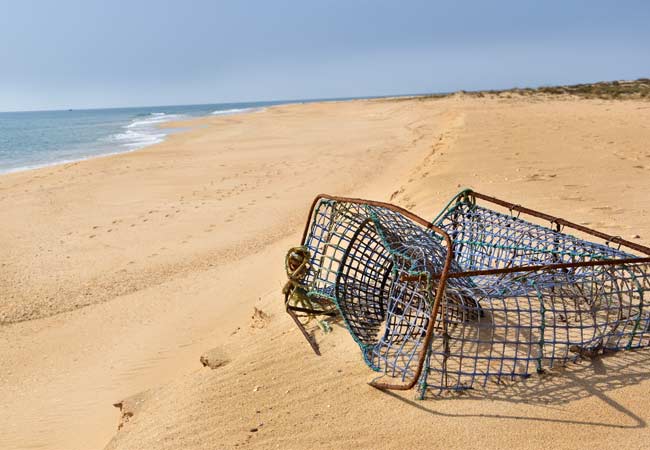
Ilha Deserta: A deserted sandbar island on the southern side of the Parque Natural da Ria Formosa, known for its unspoiled, 6km-long coastline of sandy beaches. Along this coastline is the Cabo de Santa Maria, the southernmost point of Portugal.
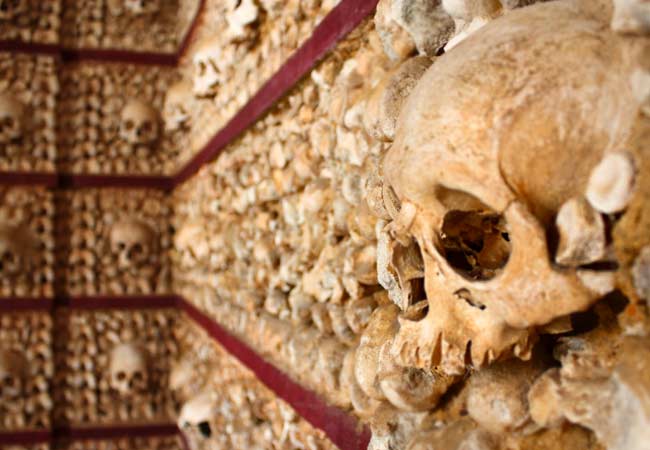
Faro Bone Chapel (Capela dos Ossos): A ghoulish chapel decorated with the bones of 1,200 monks exhumed from the graves of the Nossa Senhora do Carmo church.
Want to explore more?
Discover the famous Bone Chapel, the historic Old Town walls, and the Ria Formosa in our in-depth guide to
Sights and Activities in Faro.
Faro as a day trip
aro is the premier day trip of the central Algarve region, particularly for those staying in Albufeira, Vilamoura or Quarteira. The city is home to many fascinating historical landmarks and has a unique Portuguese atmosphere that sets it apart from the surrounding resort towns.
Insight: The central Algarve region boasts many interesting day trips, such as the fishing port of Olhão and market town of Loulé. However, Faro is the superior day trip destination due to its wider array of sights and attractions.
To fully discover Faro, plan at least four hours of sightseeing. The first half of the day could be dedicated to exploring the Cidade Velha, and the second half to visiting the modern area of Faro, which includes the Capela dos Ossos (Bone Chapel).
Boat tours of the Parque Natural da Ria Formosa are often full-day activities, but there are shorter trips to the Ilha Deserta if you wish to see the nature park during your day trip.
Being the largest city in the Algarve, Faro has excellent public transport connections from the surrounding region (details provided later). If you have a car, there is a large car park to the southeast of the city (GPS: 37.01, -7.93).
The interactive map below displays a suggested day trip to Faro. The green line indicates a walking tour of the city, which starts from the bus station. (Note: zoom out to view all points).
Sights of the tour: 1) Faro Marina 2) Manuel Bivar plaza 3) Igreja da Misericórdia (church) 4) Arco da Vila (gateway) 5) Porta Nova 6) Sé Cathedral 7) Câmara Municipal (City Hall) 8) Faro Museum 9) Arco do Repouso (gateway) 10) Rua de Santo António (shopping street) 11) Igreja de São Pedro 12) Igreja do Carmo 13) Capela dos Ossos
Sights around Faro: 14) Cabo de Santa Maria 15) Ilha Deserta 16) Culatra fishing village 17) Forum Algarve (shopping centre) 18) Start of the N2 road*
Beaches: 19) Praia de Faro 20) Praia Da Ilha Deserta 21) Praia do Farol 22) Praia da Ilha da Culatra
*The N2 is the scenic road that extends along the entire length of Portugal, popular for road trips and motorcycle trips.
Sights for a day trip to Faro
Faro Marina: Here, a mix of fishing boats and pleasure craft moor, but the height of the boats is severely restricted due to the railway bridge at its entrance!
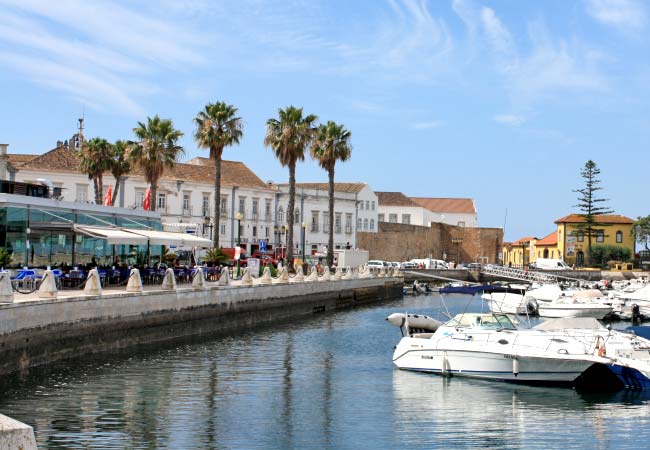
Arco da Vila: The decorative Baroque gateway constructed over the original Arabic gateway, leading into the Cidade Velha. The towers of the Arco da Vila are a favourite nesting site for Faro’s storks.
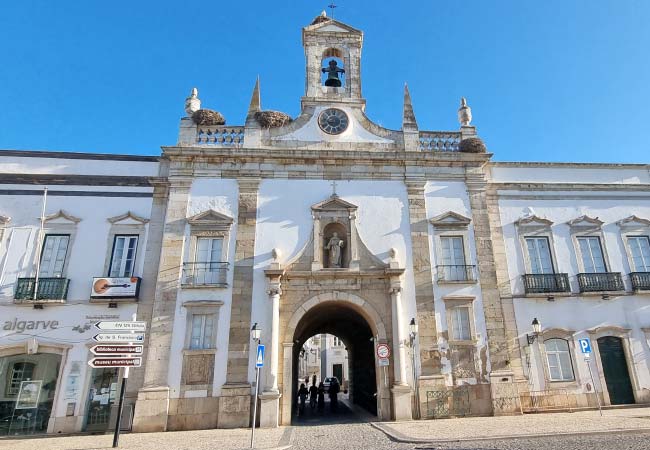
Porta Nova: The tiny gateway that leads down to the waterfront and the “Cais de embarque de Faro”, where the ferries and boat tours depart.
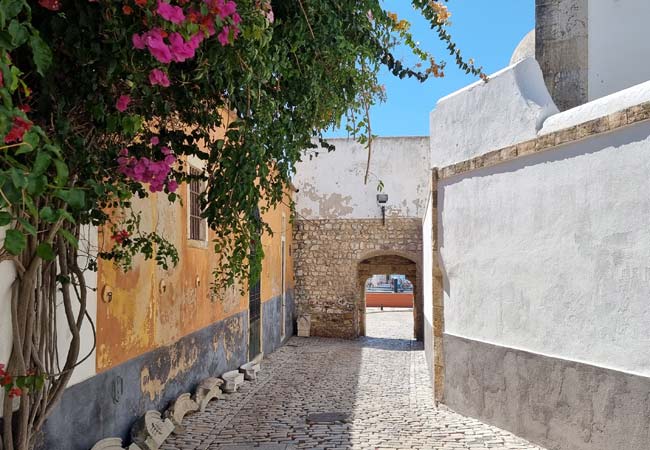
Rua de Santo António: The characterful shopping street of central Faro.
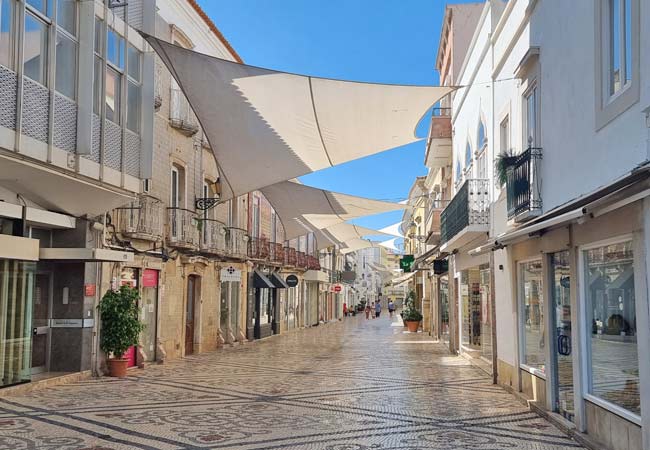
Cathedral Tower View: The view from the top of Faro cathedral offers panoramas over the city and the Parque Natural da Ria Formosa.
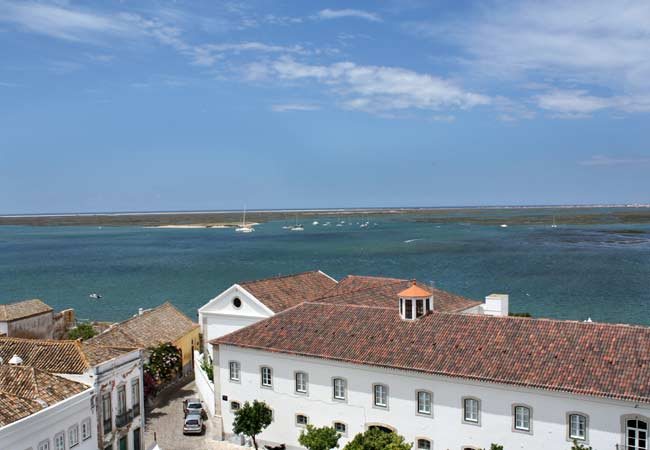
Igreja do Carmo: This grand Baroque church was funded by the spice trade from Brazil; the Capela dos Ossos is located in the rear courtyard.
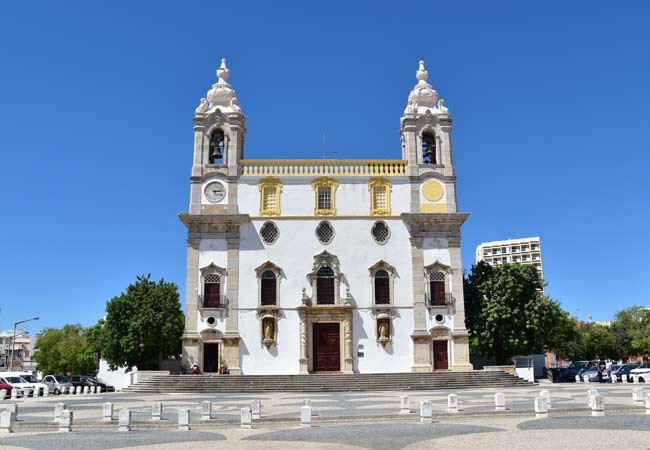
Faro holiday score and ratings
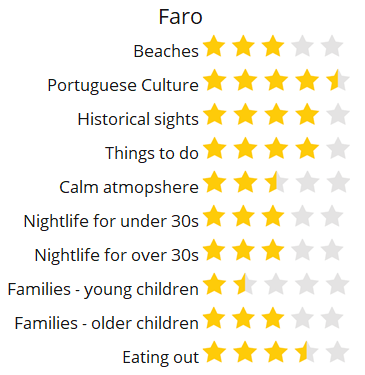
Faro activities and tours
There are many excellent tours and activities in Faro. The Parque Natural da Ria Formosa and the Ilha Deserta are often the focus, as they can only be reached by boat. Highly rated activities include:
• A boat tour of Ria Formosa visiting two islands
• A nature tour on a solar-powered boat
• A dolphin watching tour
Faro for a holiday
Faro makes an enjoyable, if slightly alternative, holiday destination. The city is ideal for an authentic Portuguese experience rather than a conventional beach holiday.
Faro offers history and culture, along with a varied selection of cafés, restaurants and bars. As a major city, the nightlife is vibrant and tends to cater to Portuguese patrons rather than foreign tourists. By day, Faro has an unhurried ambience, but by night it transforms into a buzzing social hub.v
Insight: Faro has no beaches within walking distance of the city centre; a bus (to the Praia de Faro) or ferry (Praia Da Ilha Deserta) is required. Consequently, Faro is not a destination for a beach-focused holiday.
Faro is a strategic base for exploring the Algarve by public transport. Tavira is only 40 minutes by train to the east, Vilamoura is 30 minutes by bus to the west, and even Lagos, at the westernmost edge of the Algarve, can be reached by a direct train.
Visitors considering a holiday to Faro should note that this is a major residential city, not a manicured resort town. Some sections of the city are dilapidated (though perfectly safe) and, unfortunately, are on the main bus route into the city, which can give a poor first impression. This perception invariably changes once the historic centre and harbour are discovered!
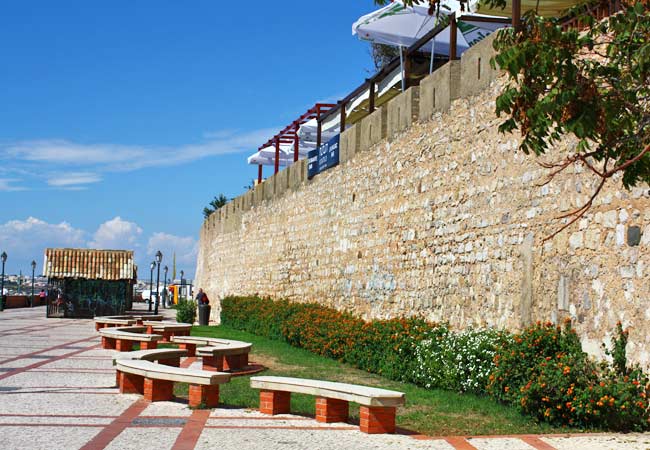
The city walls of Faro date from the Moorish era and encircle the entire Cidade Velha
How long to spend in Faro?
Recommended stay lengths are one day, three days or a week.
A one-day stay is recommended for those arriving on a late flight requiring a short stopover before heading to a main holiday destination. Faro can be easily explored in a single day, providing an interesting introduction to the Algarve before travelling to the next location.
A stay of three nights allows Faro and the surrounding region to be fully discovered. This duration provides time to explore the historic centre, tour the Parque Natural da Ria Formosa, relax on the Praia de Faro or Ilha Deserta beaches, and take a day trip to Estoi or the Ilha da Culatra. Three nights is the ideal length for touring the Algarve without rushing.
A seven-night stay is perfect for spending an entire holiday based in Faro. This option utilises the excellent public transport network to explore the central Algarve via day trips, while being based in a cosmopolitan city.
From Faro, it is possible to take day trips to Olhão, Tavira, Loulé, Albufeira and Vilamoura, while longer train journeys connect to Silves and Lagos.
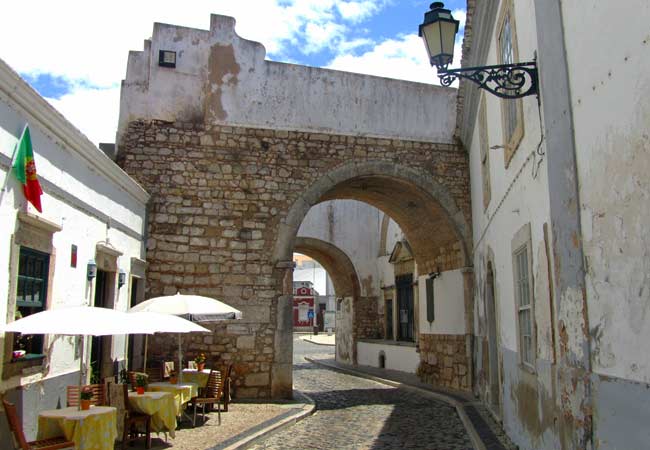
The Arco do Repouso gateway leading into the Cidade Velha.
Where to stay in Faro?
Generally, most tourists book accommodation within 300m of the Jardim Manuel Bivar plaza and the Doca de Faro. Faro is a compact city, and this area covers the main tourist sights, the bus and train stations, and popular restaurants.
Regarding hotels, the Hotel Faro and Eva Senses Hotel are both highly regarded, feature roof terraces and are centrally located. A suggested budget alternative is the Stay Hotel Faro Centro. For a hotel close to Faro airport, consider the Hotel 3k.
The map below displays the location of hotels and rental rooms in Faro; adjusting the dates to your holiday will display current prices:
The beaches of Faro
Faro city should not be considered a primary beach holiday destination. The beaches of Faro are found on the southern side of the three sandbar islands (Ilha de Faro, Ilha Deserta and Ilha da Culatra) and are not accessible on foot.
The Ilha de Faro boasts a 5km coastline of golden sands known as the Praia de Faro. Despite being less than a five-minute drive from Faro airport, Praia de Faro maintains low-key tourist development, with relaxed cafés and small beach bars.
A direct bus (route 16) connects the Próximo Bus Station (in Faro) to the Praia de Faro beach; this route also serves the airport.
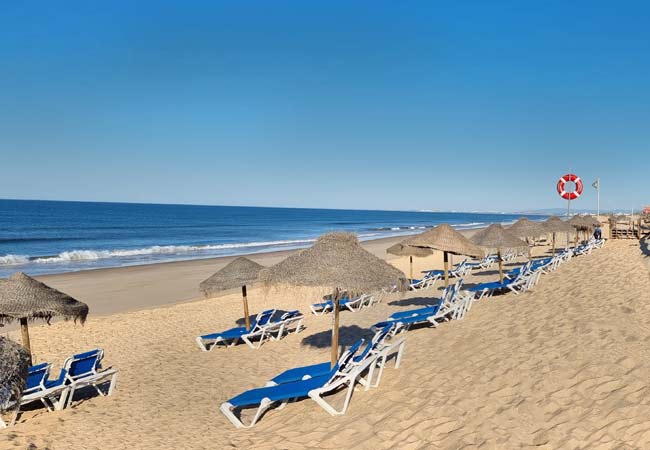
Praia de Faro, just a short bus ride from Faro
As the name implies, Ilha Deserta is an uninhabited sandy island accessible only by boat. The southern part of the island features a beach called Praia da Ilha Deserta, which stretches for over 6km and is known for its pristine, unspoiled sands. Midway along the beach is Cabo de Santa Maria, the southernmost point of Portugal.
A wooden boardwalk traverses the northern side of the island, passing through sparse beach scrub vegetation. Despite its secluded beauty, Praia da Ilha Deserta is not the most convenient destination for a beach trip, and many visitors opt for the more accessible Praia de Faro instead.
Ilha da Culatra has similar beaches to Ilha de Faro, while the northern side of the island hosts the traditional fishing village of Culatra. On Ilha da Culatra, the main beaches are Praia da Ilha do Farol and Praia da Ilha da Culatra. Farol beach adjoins the lighthouse and is closer to Faro. Since a ferry is needed to travel to Ilha da Culatra, Praia de Faro remains the superior destination for most day-trippers.
Related articles: Faro beaches
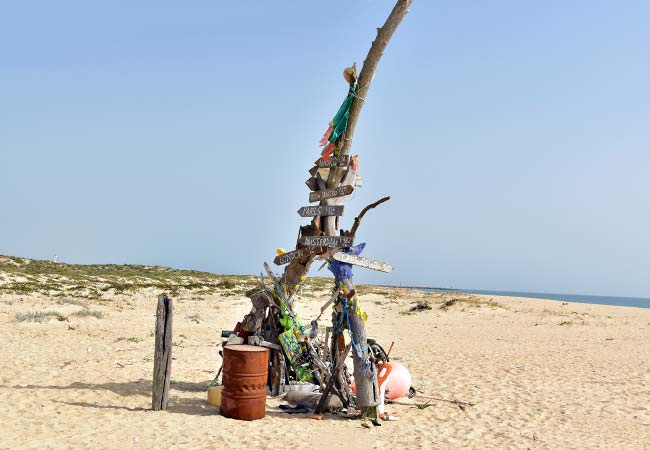
The Cabo de Santa Maria is marked by a driftwood and sea-waste monument
Faro weather
Faro is the Algarve’s transport hub
Located 7km southwest of the city, Faro Airport is the main international airport of southern Portugal. Faro bus and train stations are centrally located, and departing from here are regional services covering the entire Algarve, along with routes to Lisbon and northern Portugal.
Useful public transport websites include:
• Comboios de Portugal (trains) - www.cp.pt
• Vamus (regional buses) - vamusalgarve.pt
• Rede Expressos (intercity buses) - www.rede-expressos.pt
Notably, none of these public transport services connect directly to the airport. Consequently, if you wish to head to your holiday destination using public transport, you must travel into Faro city first.
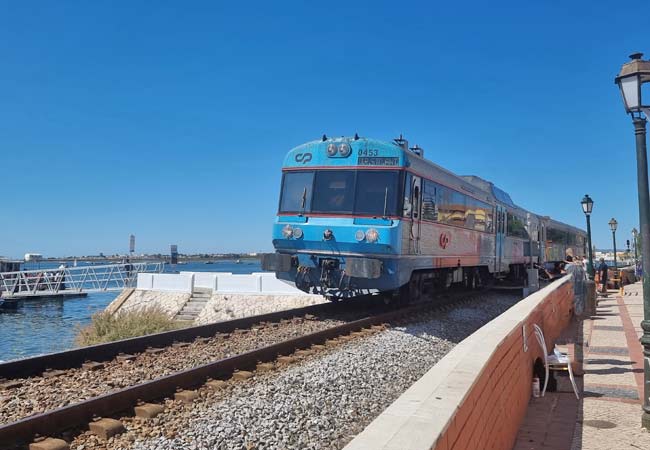
The Algarve regional railway, slow but inexpensive
How to travel from the airport to Faro city
Public transport from Faro airport to the city is limited. There is a single bus service (€2.80 adult) that departs every 30-40 minutes between 6am and midnight. This bus (route 16) terminates at the Próximo bus station, situated next to the intercity bus station and 200m from the train station.
A taxi from the airport to Faro is a faster and more convenient option, costing €15-20. Uber operates in the Algarve, but demand can be high during the summer months. The price for a private transfer (with a driver waiting at the airport) starts from €25; more details can be found here..
Related articles: Faro airport to Faro city
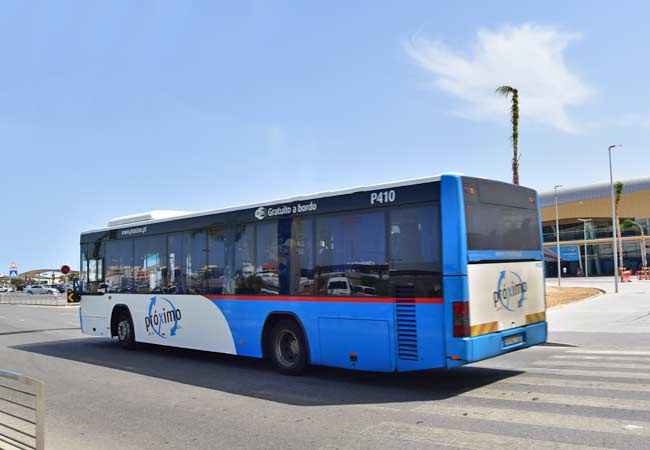
The number 16 bus heading to Faro bus station
Day trips from Faro
Popular day trips from Faro include the fishing town of Olhão, the market town of Loulé or the fishing communities on Ilha da Culatra.
An alternative day trip is to the pretty village of Estoi. Located in Estoi is the pink Palácio de Estoi, the finest example of Rococo architecture in the Algarve. Just outside the village lie the Milreu Roman ruins, remnants of a once-grand villa.
Related Articles: Day trip to Estoi – Loulé guide
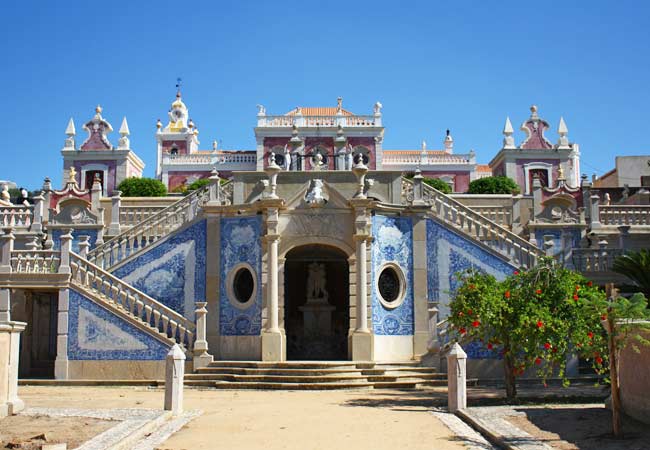
The beautiful azulejos tiles of the Palácio de Estoi gardens.
Our most popular guides for Faro and the Algarve
All of our guides to the Algarve
